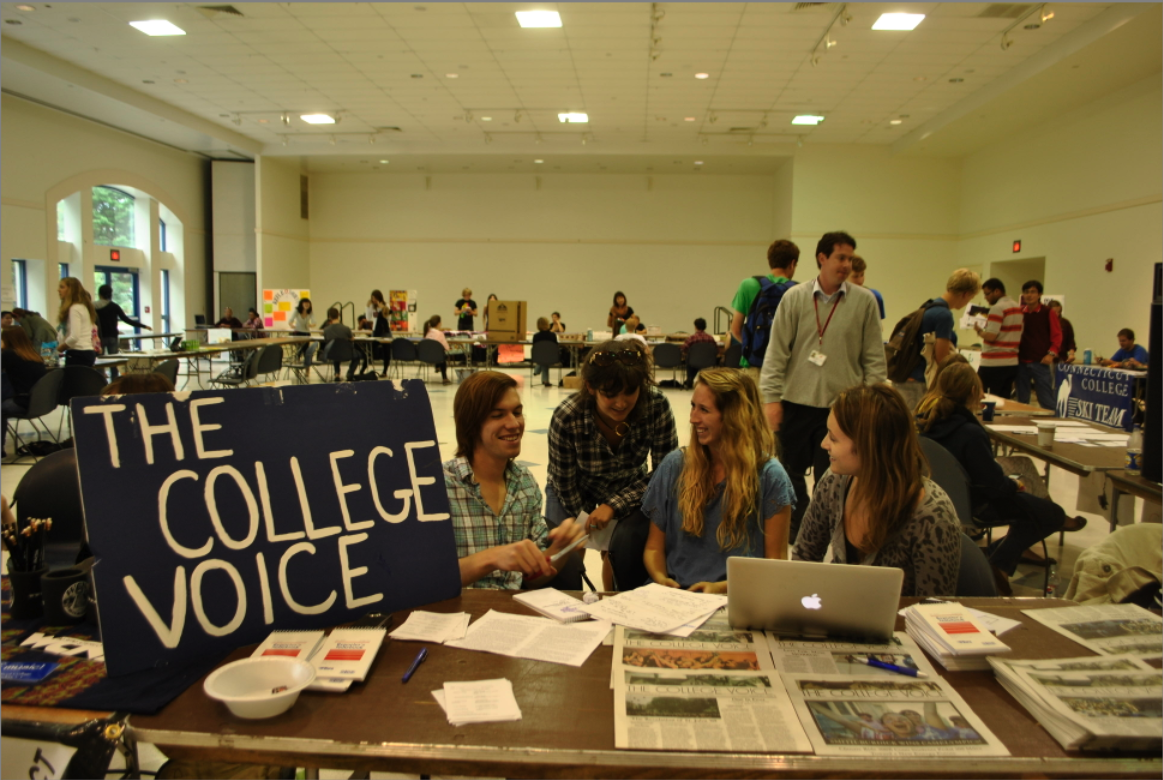There are clubs on this campus with no more than ten active members. Imagine the Voice with each section as a different publication.
Each section editor has an average of 30 students on their contact list, so hypothetically, if news, opinions, arts and sports all had individual SGA funding, they’d all have to find individual printers, print out individual broadsheet pages and figure out individual systems for distributing those publications throughout campus. They’d each need a treasurer, a weekly meeting, and a set of computers, photographers and web editors. If I were to wake up one morning and suggest we put everything in one publication, it would be jarring – understandably, every club leader would have trouble letting go and collaborating. But we know from our 35-year history, and any experience in journalism, that this is the way you run a newspaper.
The other day I counted the number of students in the staff box at right for last week’s issue – it took 51 students in total to put together one issue of the Voice. Last year, we had over 130 total writers. We’re such an active club partially because we were built with tiers.
Last week, 60 clubs received a monetary allocation from the Student Government Association’s Finance Committee. At Thursday’s SGA meeting, members of the committee expressed concern about how to keep up with the funding requests. In total, the clubs asked for $211,302.22. The total amount distributed was $107,871.38. This club funding process is all-inclusive: the Committee gives money to clubs as diverse as the CC Equestrian Team and the Inter-Varsity Christian Fellowship.
Said 2012 Class President D’Larys Rivera, “A lot of clubs overlap. We don’t have a lot more money to give out, but many of them can collaborate.” They’re currently looking to reevaluate the standards for sponsoring and approving clubs.
The question is, how do you draw intelligent boundaries? Should REC have a say in what happens in Forest Justice? Probably not. But should REC, Forest Justice, Oceana, Sprout! and Spokespeople all be under a Connecticut College Environmentalist Association? Ian Phillips, the SGA Chair of Environmental Affairs, recently formed an executive board with the presidents of each club called the Environmental Leadership Committee. Great. Now why not take it a step further, where they give themselves one treasurer, and have that treasurer petition a large chunk of money from Finance for all environmental affairs? It’d give clubs more autonomy.
There’s nothing if not too much inertia at Conn College. Someone decided on the term “apathy” one day, and it stuck onto this college, like any good buzzword does. But the word feels soulless. We are not emotionally empty, are we? We have clear passion for our endeavors. Read Nora Swenson’s article on the newly initiated French Club and see that the students in these clubs have high aspirations. Perhaps a better term is complacency: uncritically satisfied with our routines, comfortably entrenched in our systems and not bothered to turn them upside down. It’s left us with 60 clubs, many of which have no more than 10 impassioned members, many of which overlap.
College club funding offers us the rare occasion to interact with money without putting any of it in our pockets, as we vie for funding strictly to create events for the betterment of our community, not the betterment of our bank accounts. Here we are allowed dispassionate interaction with large sums, because the money isn’t to feed our family or pay for our rent. So why not re-shift the focus here, by holding club leaders to a higher level of power, agency and independence. Instead of the Finance committee and SGA deciding that CQ2 (Connecticut College Queer and Questioning) isn’t allowed money because they “discriminate” against heterosexuals, they give the LGBTQ Partnership a certain amount of money that its executive board members distribute amongst themselves (this would include SPECTRUM, CQ2, and the Coalition for Gender Identity Awareness).
There is one problem this creates: the constant battle with the Student Organizations Funding Office. With students paying their club expenses and SOFO paying them back, the College has set up a system where unless you can request an advance receipt to give SOFO, wait two weeks to receive a check, and give it to a vendor that accepts checks at all, you are forced to spend your own money ordering materials, only to be paid in check by SOFO two weeks later. (Last week, I spent $850 of the little money I made this summer to buy apparel the Voice is selling at Harvest Fest. I’m still waiting for SOFO to pay me back.) It’s a liability to hand out 60 credit cards for 60 clubs. But credit cards have been the standard method of transaction since the mid-80’s. Let more groups combine and give us the responsibility we deserve – we’ll step up.
If you want clubs with similar interests to collaborate, it’s important that they streamline their operations. The more you buy, the cheaper it gets. Buy food for club meetings in bulk, buy all club sports team uniforms from the same vendor, buy hundreds of vuvuzelas and create an interclub league initiative to attend games. It won’t happen overnight, as growing organizations ultimately means relinquishing control. But imagine every year at funding time, instead of competing against each other, clubs were pooling together?
-Lilah Raptopoulos









